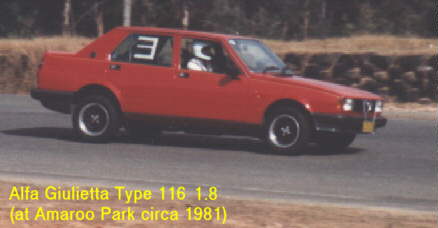

Index
Get a life! Or one person's diatribe on staying alive. Skippable.
Handling 101 - What's handling good for?
Handling 102 - Let's get technical about handling
Handling 103 - Adjusting your car's handling characteristics
Tyre pressures matter
Camber plays a part
Sometimes you must Toe the line!
Caster look over 'ere, mate!
Having a Polar Moment
Roll Over Beethoven
Oversteer
Understeer
Weight transfer explained
Shuffle off this mortal Coil
Tyres and Wheels can do more than just look good
Pitching a fast ball
Other stuff people often don't understand
Heel and Toe
Double declutch
Wheel offset
Rollbars
CVT - Constantly variable transmission
Twin camshaft motors
GTV - Grand Touring Veloce
GTi - Grand Touring Injection
GTam - Grand Touring America or maybe Allegerita Modificato
RS - Rally Sport or Renn Sport
GTO - Grand Touring Omologato
Positive camber is when, looking from the front (or rear), your wheels are sloping inwards towards the bottom. In other words the distance is greater from the top of one tyre to the top of the opposite tyre, compared with the distance from the bottom of one to the other tyre. Conversely, negative camber has the wheels sloping outwards, so that they meet the road with a wider track, compared with the top of the wheel. It looks like the car has been dropped from a great height and the wheels have splayed outwards. This splayed-out look is cool, and very useful!
However optimum grip occurs when the wheel and tyre are perpendicular to the road surface, something you don't have when you have any camber on your wheels. The de Dion-style rear suspension of the Alfa Romeo Alfetta is designed to do exactly that task, allowing no camber change during cornering. So why use camber? Well, when your car corners, the force of the turn will act on the tyre, deforming it, and also act against the good intentions of the suspension design. From perpendicular you could find yourself with an unintended positive camber under high cornering loads. And with positive camber comes relatively more grip loss, compared with negative camber (because the cornering forces drive the tyre "under" the rim, effectively lifting the tread off the road in a positive camber setup). Whilst the de Dion design does probably the best job imaginable at keeping the tyres square to the road, it is an expensive solution that doesn't translate well to most mass-produced cars.
Negative camber causes 'side' or 'camber' thrust, acting inwards. This assists grip in corners, because the cornering force will tend to force the wheel towards the perpendicular. However all is not rosy because negative camber will cause wandering if bumpy roads are encountered. Because side forces are generated, hitting a bump may cause the side forces to be unequal and the car will unintentionally steer itself towards the bump. On a racetrack you will learn where the bumps are and go for the maximum useful camber setting, but on a public road you will compromise. Look at the front wheels of the exemplary-handling Alfa Romeo Alfasud for an example of noticeable negative camber. This is to counteract the front-wheel-drive's characteristic understeer. Similarly you will see rear wheel negative camber in use on many sporty, slightly taily BMWs, for similar reasons, but to counteract oversteer.
Examples of positive camber are less common, but some early Subaru four wheel drives have that characteristic inward lean on the front tyres (and worn out inner edges). And if you jack a swing axle VW Beetle or Mercedes off the ground they will show you exactly what happens when you lift off the throttle in one of those cars. The rear wheels head inwards, quickly. Which is why you do not suddenly lift off the throttle mid-corner in such cars!
Everything's a balancing act. Negative camber will also reduce traction, and that's something that you don't want when accelerating hard from rest or in low gears (especially in in the wet). And that same traction-loss applies to braking, so once again we have to decide where to compromise. Factors to consider with traction include which end of the car does the driving (front, rear or all-wheel drive?) and weight distribution. If you have enough mass over the rear (driven) wheels of a car, the camber matters less, at least in terms of traction. Moreover you need to think carefully about the balance of forces and what you seek to achieve, before making adjustments. At least now you are getting a grasp of the intricacies of 'handling'.

